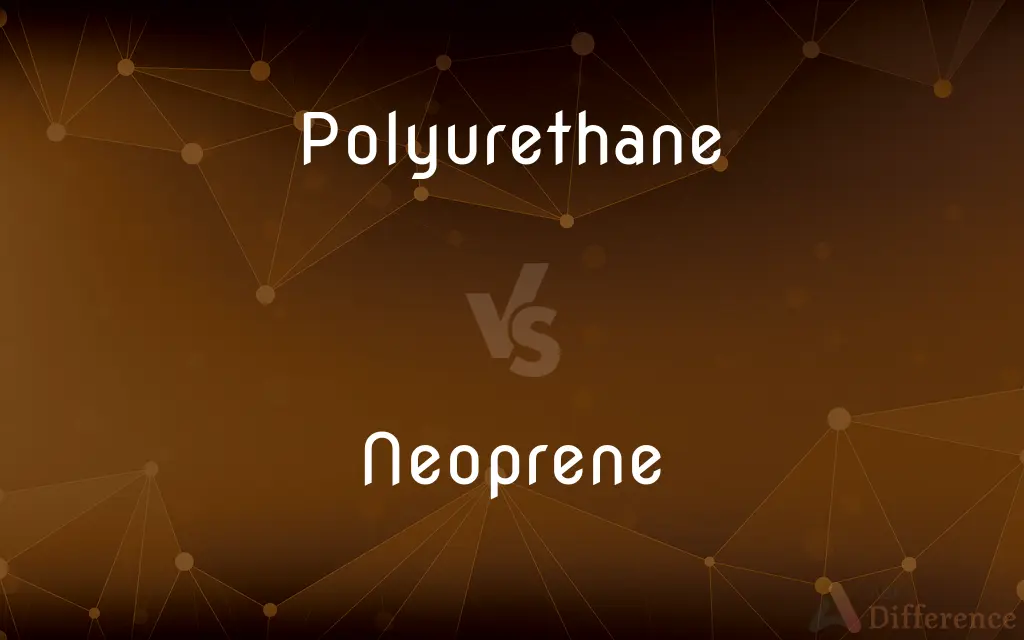Polyurethane vs. Neoprene — What's the Difference?
By Tayyaba Rehman & Fiza Rafique — Updated on February 27, 2024
Polyurethane is a versatile, durable synthetic polymer known for its hardness and resistance to wear, while Neoprene is a soft, flexible rubber that excels in waterproofing and thermal insulation.

Difference Between Polyurethane and Neoprene
Table of Contents
ADVERTISEMENT
Key Differences
Polyurethane stands out for its exceptional durability and resistance to abrasion, chemicals, and oil, making it ideal for industrial and automotive applications. Its versatility allows it to be tailored into various forms, from rigid foams to elastic coatings. Neoprene, on the other hand, is celebrated for its excellent waterproofing, insulation, and weather-resistant properties. This synthetic rubber is commonly used in wetsuits, gaskets, and hoses, benefiting from its flexibility and moderate resistance to oils and chemicals.
Polyurethane is often preferred for applications requiring high wear resistance and strength, such as in wheels, industrial floors, and varnishes, neoprene finds its niche in environments demanding insulation against temperature and moisture. Neoprene’s ability to maintain flexibility over a wide temperature range makes it suitable for outdoor gear and protective coverings.
Polyurethane's chemical structure provides a broader range of hardness, which can be adjusted from soft and flexible to hard and rigid. This adaptability makes it useful in both soft applications like sponges and hard ones like electronic instrument cases. Neoprene, with its inherent flexibility and cushioning effect, is favored for products requiring a good seal and vibration dampening, such as in automotive door and window seals.
The environmental resistance of polyurethane varies with its formulation, offering options that are highly resistant to UV light and ozone, critical for outdoor applications. Neoprene, inherently resistant to sunlight, ozone, and weathering, is a go-to material for outdoor applications without the need for special additives or treatments.
Neoprene's uniformity and consistency in physical properties across its types make it a reliable choice for standardized products. Polyurethane’s versatility, however, means its properties can be extensively customized, leading to a wider range of potential applications but requiring more precise selection to meet specific needs.
ADVERTISEMENT
Comparison Chart
Base Material
Synthetic polymer
Synthetic rubber
Flexibility
Ranges from very flexible to very rigid
Generally flexible and soft
Durability
High wear, chemical, and oil resistance
Moderate resistance to oils and chemicals
Applications
Industrial floors, automotive parts
Wetsuits, gaskets, hoses
Temperature Range
Wide, varies by formulation
Good, maintains flexibility in cold
Weather Resistance
Varies, can be UV and ozone resistant
High resistance to sunlight and ozone
Insulation
Depends on formulation, generally low
Excellent thermal and moisture insulation
Compare with Definitions
Polyurethane
Can be rigid, serving as structural and insulative materials.
Rigid polyurethane foam is used in insulation panels.
Neoprene
Maintains its properties across a wide temperature range.
Neoprene hoses perform well in both hot and cold temperatures.
Polyurethane
A durable synthetic polymer used in various applications for its wear resistance.
Polyurethane coatings protect floors from scratches and spills.
Neoprene
A synthetic rubber known for its flexibility and waterproof qualities.
Neoprene wetsuits are essential for divers to stay warm underwater.
Polyurethane
Customizable for hardness and elasticity, fitting a wide range of uses.
Polyurethane wheels are tailored for hardness to handle heavy loads smoothly.
Neoprene
Moderately resistant to oils and chemicals, suitable for industrial gaskets.
Neoprene gaskets are utilized in machinery for leak prevention.
Polyurethane
Exhibits excellent chemical resistance, suitable for industrial environments.
Polyurethane hoses are used for transferring oils and chemicals.
Neoprene
Offers thermal insulation, used in protective clothing and accessories.
Neoprene gloves keep hands warm in cold environments.
Polyurethane
Flexible when formulated into elastomers, ideal for cushions and soft foams.
Polyurethane foam is commonly used in furniture cushions for comfort.
Neoprene
Resistant to weathering, ozone, and sunlight, ideal for outdoor applications.
Neoprene seals are used in windows to withstand harsh weather conditions.
Polyurethane
Polyurethane (often abbreviated PUR and PU) is a polymer composed of organic units joined by carbamate (urethane) links. In contrast to other common polymers such as polyethylene and polystyrene, polyurethane is produced from a wide range of starting materials (monomers) and is therefore a class of polymers, rather than a distinct compound.
Neoprene
Neoprene (also polychloroprene) is a family of synthetic rubbers that are produced by polymerization of chloroprene. Neoprene exhibits good chemical stability and maintains flexibility over a wide temperature range.
Polyurethane
A synthetic resin in which the polymer units are linked by urethane groups, used chiefly as constituents of paints, varnishes, adhesives, and foams
Five coats of polyurethane
Polyurethanes serve a variety of uses
Neoprene
A synthetic rubber produced by polymerization of chloroprene and used in weather-resistant products, adhesives, shoe soles, sportswear, paints, and rocket fuels.
Neoprene
A synthetic rubber, a polymer of chloroprene, commonly used in wetsuits, laptop sleeves, orthopedic braces, electrical insulation, liquid and sheet-applied elastomeric membranes and flashings, car fan belts, etc.
Neoprene
A synthetic rubber that is resistant to oils and aging; used in waterproof products
Common Curiosities
What is polyurethane best used for?
Polyurethane is best used for applications requiring durability, flexibility, and resistance to abrasion and chemicals, such as in coatings, foams, and industrial parts.
Is polyurethane or neoprene more durable?
Polyurethane generally offers greater durability, especially in terms of wear and tear and resistance to chemicals and oils.
Can polyurethane and neoprene be used interchangeably?
While they can sometimes serve similar purposes, their distinct properties often make them suited to different applications; interchangeability depends on the specific requirements of the use case.
How do the costs of polyurethane and neoprene compare?
Costs can vary widely based on the specific type and application; generally, polyurethane can be more cost-effective for certain applications, while neoprene's specialized properties might justify its cost in others.
Which is better for outdoor use, polyurethane or neoprene?
Neoprene is often better for outdoor use due to its inherent resistance to weathering, ozone, and sunlight, though specific polyurethane formulations can also be suitable.
Can polyurethane be made to mimic the properties of neoprene?
Through formulation adjustments, polyurethane can be engineered to mimic some of neoprene's properties, though not all aspects may be perfectly replicated.
What is the temperature range for polyurethane?
The effective temperature range for polyurethane varies by formulation but can be from below freezing to above 200°F.
Can polyurethane be recycled?
Yes, polyurethane can be recycled, though the process and feasibility depend on the type of polyurethane and the recycling facilities available.
What makes neoprene unique?
Neoprene's unique qualities include its excellent waterproofing, thermal insulation, and resistance to weather, ozone, and sunlight, making it ideal for outdoor and aquatic gear.
What industries commonly use neoprene?
The automotive, marine, construction, and sporting goods industries commonly use neoprene for various applications.
Are there environmental concerns associated with polyurethane or neoprene?
Both materials raise environmental concerns regarding their production and disposal; however, advancements in recycling and more eco-friendly formulations are being developed.
How does neoprene perform in cold temperatures?
Neoprene performs well in cold temperatures, maintaining its flexibility and insulation properties.
Is polyurethane resistant to UV light?
Some formulations of polyurethane are resistant to UV light, making them suitable for outdoor applications.
Share Your Discovery

Previous Comparison
Maltose vs. Isomaltose
Next Comparison
ECG vs. EEGAuthor Spotlight
Written by
Tayyaba RehmanTayyaba Rehman is a distinguished writer, currently serving as a primary contributor to askdifference.com. As a researcher in semantics and etymology, Tayyaba's passion for the complexity of languages and their distinctions has found a perfect home on the platform. Tayyaba delves into the intricacies of language, distinguishing between commonly confused words and phrases, thereby providing clarity for readers worldwide.
Co-written by
Fiza RafiqueFiza Rafique is a skilled content writer at AskDifference.com, where she meticulously refines and enhances written pieces. Drawing from her vast editorial expertise, Fiza ensures clarity, accuracy, and precision in every article. Passionate about language, she continually seeks to elevate the quality of content for readers worldwide.
















































